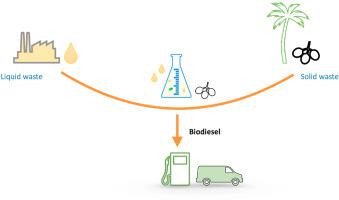Biomass & Bioenergy ( IF 6 ) Pub Date : 2020-09-25 , DOI: 10.1016/j.biombioe.2020.105768 Emmanuel Quayson , Jerome Amoah , Nova Rachmadona , Kenta Morita , Lawrence Darkwah , Shinji Hama , Ayumi Yoshida , Akihiko Kondo , Chiaki Ogino

|
Continuous expansion of agriculture for the production of biofuels may be considered a potential source of greenhouse gas (GHG) emissions due to the ever-increasing amount of waste and fossil fuel-dependent materials involved. Agricultural waste utilization through the circular bioeconomy concept offers a pathway to reduce GHG emissions. Palm oil production, for instance, produces palm kernel shells (PKS) and palm oil mill effluents (POME) as wastes in enormous amounts. PKS and POME account for >60% of solid and liquid waste generated from the mill. In this work, the feasibility of a circular palm bioeconomy is explored where waste PKS is directly converted to activated carbons (AC) in a cost-effective one-step technique (550 °C, 10 mL min−1 N2) that departs from the conventional two-step (carbonization and activation) technique. Characterization of the synthesized carbons, PKAC, using Fourier-transform infrared spectroscopy and scanning electron microscopy with energy-dispersive X-ray spectroscopy showed oxygen-rich morphological features that were 2-fold higher than in bituminous coal-derived AC. The <10 μm pore diameters of PKAC were relevant in the immobilization of Aspergillus oryzae whole-cells expressing Fusarium heterosporum lipase (PKAC-FHL). For biodiesel production, the 81.6 IU mg−1 specific activity of PKAC-FHL yielded ≥97.5 wt% fatty acid methyl ester (FAME) from POME. While offering the benefits of environmental remediation through effluent utilization, the produced FAME showed 48.8 Cetane Number and cold-flow properties that conform to ASTM and EN biodiesel requirements. This waste valorization approach, thus, proposes a green framework for the use of POME and PKS in immobilized lipase-catalyzed methanolysis.
中文翻译:

将棕榈生物量废物转化为碳基质,以将重组镰孢镰刀菌脂肪酶固定在棕榈生物柴油合成中
由于不断增加的废物和依赖矿物燃料的材料的数量不断增加,农业不断扩大以生产生物燃料的可能性被认为是温室气体(GHG)排放的潜在来源。通过循环生物经济概念利用农业废物提供了减少温室气体排放的途径。例如,棕榈油生产会大量产生棕榈仁壳(PKS)和棕榈油厂废液(POME)。PKS和POME占该工厂产生的固体和液体废物的60%以上。在这项工作中,探索了圆形棕榈生物经济的可行性,其中采用成本有效的一步法(550°C,10 mL min -1 N 2)将废PKS直接转化为活性炭(AC)。)与常规的两步(碳化和活化)技术不同。使用傅里叶变换红外光谱法和扫描电子显微镜与能量色散X射线光谱法对合成碳PKAC的表征表明,富氧形态特征比烟煤衍生的AC高2倍。小于10μm的PKAC孔径与固定化表达镰孢镰刀菌脂肪酶(PKAC-FHL)的米曲霉全细胞的固定有关。对于生物柴油生产,81.6 IU mg -1PKAC-FHL的比活度从POME中产生≥97.5wt%的脂肪酸甲酯(FAME)。虽然通过废水利用提供了环境修复的好处,但生产的FAME的辛烷值和冷流特性均达到48.8,符合ASTM和EN生物柴油的要求。因此,这种废物增值方法为在固定化脂肪酶催化的甲醇分解反应中使用POME和PKS提出了绿色框架。



























 京公网安备 11010802027423号
京公网安备 11010802027423号